Although Hanyu Pinyin has been Taiwan’s official romanization system since the beginning of this year, progress in implementation on signage has so far been little to none (at least in what I’ve witnessed). So I was pleased to see this sign earlier this week at the remodeled train station in Zhunan, Miaoli County.
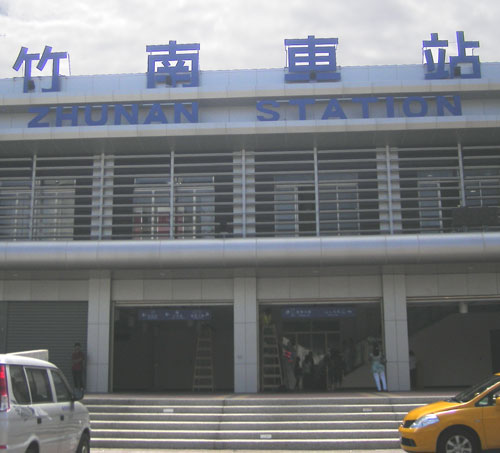
Those big letters unmistakably spell out the name of the city in Hanyu Pinyin. Good.
But what about the use of romanization inside the station? Here’s a shot of part of a board listing the stations near Zhunan.
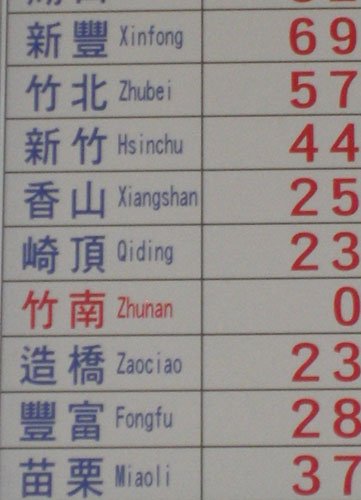
Let’s look at the systems used in the names above:
- Xinfong — Hanyu Pinyin and Tongyong Pinyin mix
- Zhubei — Hanyu Pinyin
- Hsinchu — Wade-Giles
- Xiangshan — Hanyu Pinyin
- Qiding — Hanyu Pinyin (BTW, that’s a terrible Q, as it’s too little distinct from an O, especially at a distance.)
- Zhunan — Hanyu Pinyin
- Zaociao — Tongyong Pinyin
- Fongfu — Tongyong Pinyin
- Miaoli — same in most systems
Once again we see the government’s incompetence when it comes to such simple things as spelling names correctly on signage.
But since at least “Zhunan” was right, what about signage for the same name beyond the train station?
Well, there’s still Tongyong Pinyin (“Jhunan”):
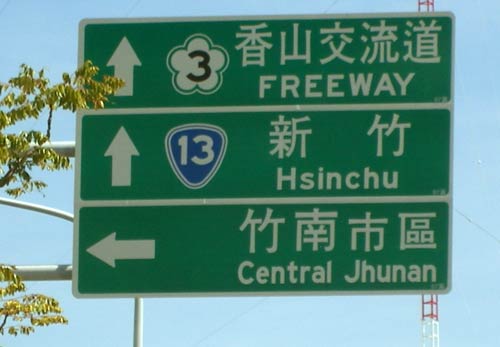
And there’s still Tongyong’s predecessor, MPS2 (“Junan”), along with other systems, typos, and sloppy English:
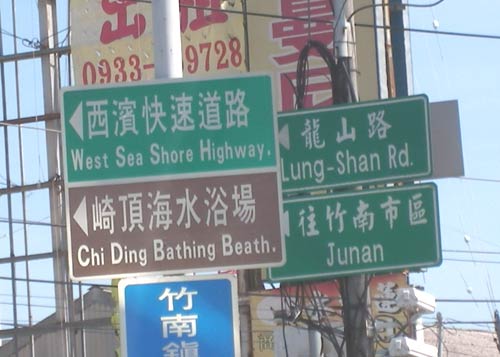
And there are still spellings that are simply wrong (“Jhuan”), regardless of the system:
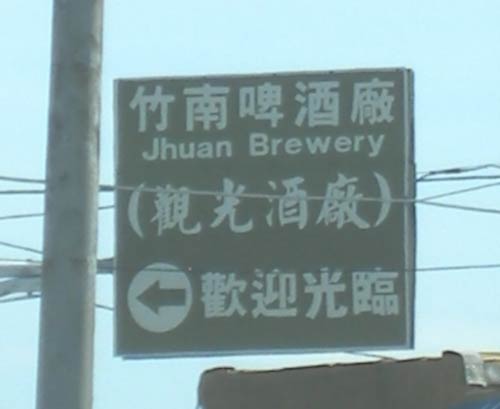
I’ve said it before, I’ll say it again: “Taiwan’s romanization situation: plus ça change, plus c’est la même chose.”

Lovely.
But after all, it’s “English”, isn’t it? And in a democracy, every Taiwanese has the right to write those names as they wish – in “English”. And don’t those weird foreigners dare to question that…
I was in Taizhong (or -chung) a couple of weeks ago, and they’ve made big improvements in the signage. However, the one thing that I saw wrong time and again (though not always) was the use of “zhueng” for “zhong”. I think someone is none-too-carefully translating Zhuyin to Pinyin…
Terrible Q? (You might incur the wrath of the Q Continuum.)
Boy, you’re really not afraid to look that gift horse in the mouth.
I appreciate the color coding and labeling. I can recognize pinyin/not pinyin, but beyond that I’m almost clueless.
Btw, the Jiayi county DMV had switched all staff name romanization to Hanyu Pinyin right after the official switch, but I spotted one name where the transcription belonged to a completely different name.
And while they seem to apply the Shnrtlgrmpf system at the Gaoxiong NHI, there too I noticed one lonely transcription where first and surname were switched, so that they followed the Chinese order.
So, it’s still “another language”, one that nobody needs to care about…
Pingback: Weekly Links – August 20, 2009 « The Daily Bubble Tea
Bathing beath?
Somehow, I am starting to regret my support for Hanyu Pinyin already. Personally, I think it is necessary for major documents, and maybe street signs. But for trains stations? Official place names. I feel Kaohsiung has a touch of distinctness to it. Gaoxiong just doesn’t look or feel right. Taizhong? Okay. Maybe. I don’t know. Already I am nostalgic. But maybe there is no place for nostalgia here? I dunno. I don’t believe Tongyong will help or hinder Taiwan’s sovereignty. The aesthetics of it are another matter. Both systems have their flaws.
> I feel Kaohsiung has a touch of distinctness to it. Gaoxiong just doesn’t look or feel right.
Gosh, I feel exactly the opposite.
Reminder about Kaohsiung in particular: In 1895, Taiwan was ceded to Japan as part of the Treaty of Shimonoseki. It was during this period that the city’s name was changed from ?? (Taiwanese: Tá?-káu) to ?? (???, Takao). While the sound remained more or less the same, the literal meaning of the name changed from “Beating Dog” to “High Hero”. After control of Taiwan was handed to the Republic of China in 1945, the official romanization of the city name came to be “Kaohsiung”, based on the Wade-Giles romanization of the Standard Mandarin reading of the kanji name.
At the Hong Kong airport, ??(Gao1xiong2) is read in
English as something approximating “Kaoxing” (pinyin approximation). I’ve met many a Chinese person who has no idea how Kaohsiung is read, that it is a city, or that it matches up to characters of the second largest city in Taiwan (if they’ve even heard of it.) Is there a standardized English pronunciation for Kaohsiung for people who don’t know to read it as “Gao1xiong2″? Sort of like a ??? reading of Mao Tse-Tung as Mao “Tsay” “Tung” (with ‘Tung’ rhyming with nothing else in the english language)
I notice that many web map providers are now just catching up with
Tongyong Pinyin.
I.e., let’s say the ruling party of Taiwan alternates back and forth
between blue and green, four years each.
And it takes about four years for the official pinyin they choose to
filter down to web map providers.
Well, that means that e.g., maps.google.com will always have the wrong
pinyin!
By the way, compare now vs. 100 years ago:
http://gissrv5.sinica.edu.tw/GoogleApp/JM20K1904_1.htm
As much as I agree with you about the ugliness of InTerCaPiTalIZaTion, the first photo could have used some. People who can’t read ?? are very likely to be unsure of whether ZHUNAN means “zhu nan” or “zhun an”. I had half expected this post to mention apostrophes.
HSK notes, if I were trying to craft a better pinyin for English speakers, I might romanize ? as “doang”, borrowing on the “oan” sound from “loan” or “groan”. Mow Dzuh Doang. Of course, it would be a bit silly to do that with the names of all famous non-Anglophones.
The “Jhuan” does exist in Tongyong, but only if it maps to the characters representing the Hanyu Pinyin spelling of “Zhuan” or the older spellings “Juan” (not the Spanish form of “John” but rather, the MPS2 romanization for “Zhuan”) and “Chuan” (Wade-Giles).
It is clear that that one sign should say “Jhunan Brewery” (in Tongyong).